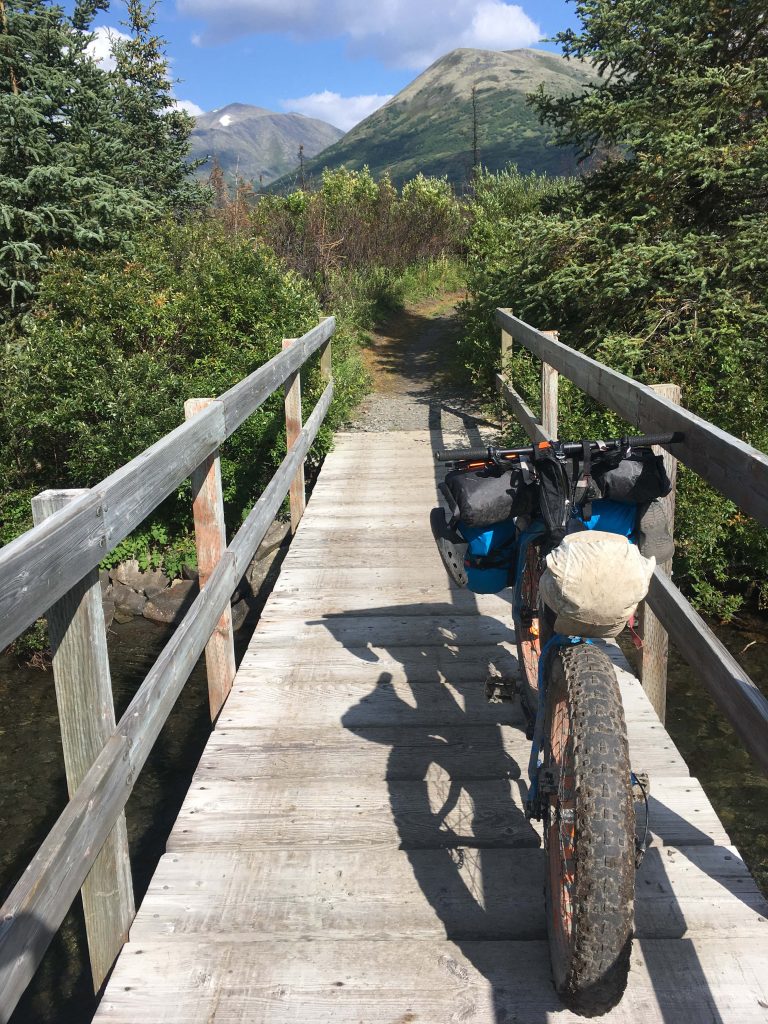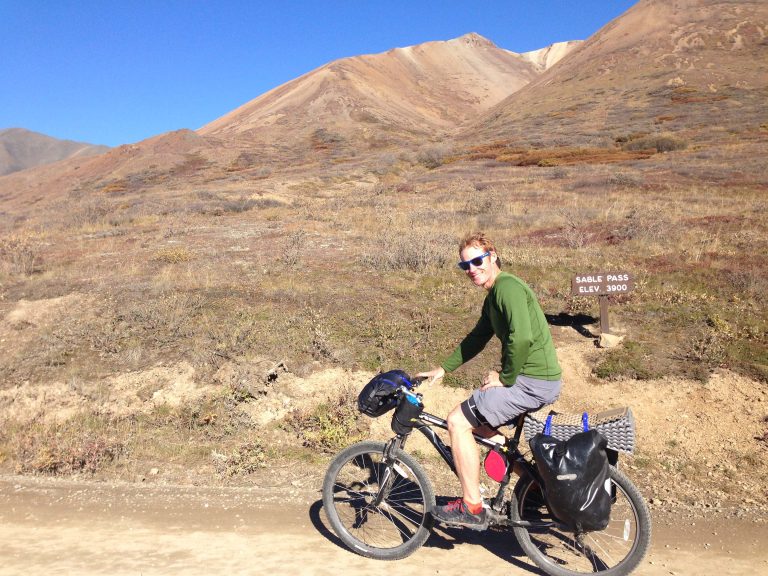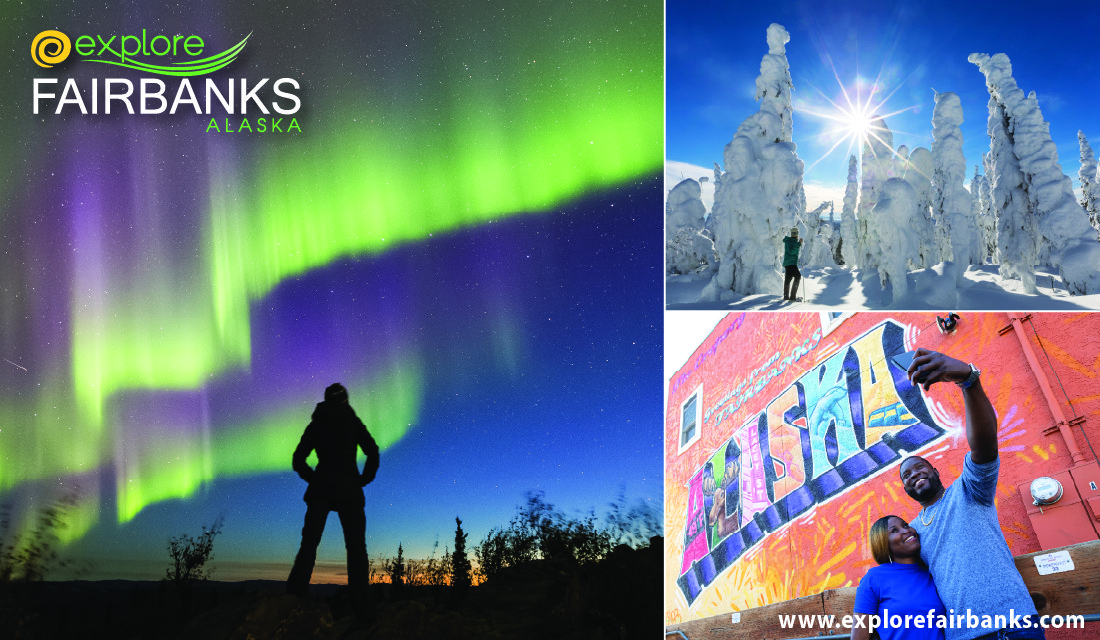Wes Hoskins, still smiling with a fully loaded bicycle at Sable Pass in Denali National Park on September 16, 2016. This was the first of several significant climbs en route to Wonder Lake. Photo by Alli Harvey.
I’d never heard of bikepacking, an alternative to backpacking, until 2015, but the idea of pedaling into the wilds of Alaska with everything I’d need stashed on my bike grabbed me and held on.
I’ve since learned that stringing together overnight trips on a bicycle in Alaska takes some planning and plenty of physical effort, but the payoff is well worth it.
Why Bikepack?
Bikepacking provides a lightweight, free way to explore, almost like you’re getting away with something. Unlike backpacking, biking allows unencumbered movement, without sore, overloaded shoulders or suffocating waist straps—because most, if not all, of your gear is distributed on the bike frame rather than your body.
Another plus: You move more quickly on a bike than on foot. On fast-forward, you absorb the landscape’s beauty all at once. At its best, cycling in Alaska’s backcountry on a bike loaded with basic necessities is nothing short of thrilling.
Preparation
Good route research, carefully packed and tested gear, and testing are essential when planning a bikepacking trip.
Gear in Alaska’s backcountry is always important, but when bikepacking it’s critical to pack carefully. It starts with the bike itself. It doesn’t need to be fancy, but the bike needs to be comfortable for you, and appropriate for your route. Generally, any mountain bike (or in my case, a fat-tire bike) will work on gravel, dirt road, or singletrack terrain.
The packing system is the other major priority. I highly recommend a combination of soft bags designed for bicycles, combined with a few extra rubber ski-straps for security or in case of gear breakdown. There are bike-specific bags that fit a surprising amount of gear.
A safety kit, including first aid supplies and basic bike tools, is a must-have.
I always do a pre-trip “shake out” ride, where I load up my bike exactly as I plan to for my trip and take an 8-to-10-mile ride on nearby comparable terrain. This prepares me for the weight of a fully loaded bike and allows me to fine tune my setup.
Shelter
Just like with backpacking, there are ways to simplify a bikepacking adventure, especially if it’s your first one.
A pre-reserved hut-to-hut bikepack will reduce the need for carrying a tent, and it’s nice to know there’s a dry, cozy interior, often with a stellar view, waiting at the end of the effort.
Reserving campsites provides more reassurance than first-come-first-served sites—though it does lock you into a destination.

Food
Pack for a bikepacking trip the same way you would for a backpacking trip in Alaska. Lightweight, compact, and high calorie foods are your friends. My favorite bikepacking snack? Peanut M&Ms. They fill my gas tank with a high gloss and rainbow-colored protein, sugar, and fat wallop when I need it most.
Gear Up
Alaska has bike shops aplenty, but for bikepacking purposes the author’s go-to is The Bicycle Shop. Enthusiastic and knowledgeable staff will help outfit riders with the necessities and maybe even a story or hot tip for the road. Beginners can also check out the comprehensive site bikepacking.com for advice.
Where to go
Denali National Park Road: With closure of the park road past Polychrome Pass (mile 43) in 2022, those looking for a solid and extraordinary intro to bikepacking have a pretty clear-cut itinerary. I recommend getting at least one overnight at Teklanika Campground, riding out from Savage, and then day-tripping farther into the park from home sweet campsite before riding out.
Resurrection Pass: The 38-mile trail on the Kenai Peninsula that runs from Hope to Cooper Landing is a popular spot for day tripping mountain cyclists, and with good reason: the relatively mellow elevation profile leading to scenic alpine meanders is the stuff of daydreams. Anticipate sections of walk-a-bike and don’t expect to land a cabin unless you book in advance. However, first-come-first-serve campsites are staged along the trail at reasonable intervals.
Denali Highway: Ready to level up your bikepacking game? This fabled, mostly gravel 135-mile route from Cantwell to Paxson is a worthy challenge for an experienced cyclist. The rugged terrain is located mostly above tree line, offering spectacular alpine vistas throughout, including opportunities for wildlife sightings. Know before you go: the Denali Highway is buried under snow all winter, so be sure to research current conditions.



Comments are closed.